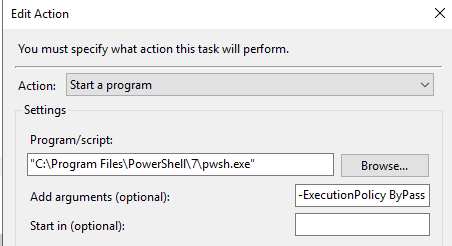On my Management Server, I have nearly always used PowerShell 5.1 for scripts. Exchange 2016 will only work with the snap-in called from 5.1 and is not compatible with PowerShell 7 (Core), because of this the scripts that don't require Exchange used 5.1 to make it easier to administer.
Recently though, I've noticed a few scripts no longer working as I update the modules. While I could go back and try to fix the issues it seems to make more sense now to start working towards moving the scripts to PowerShell Core, especially as I will shortly decommission my on-prem Exchange servers.
PowerShell Core is not without it's issues though, especially if you use a service account, with scheduled tasks, with an authenticated web proxy :(. The main issues I had to troubleshoot were:
Replace PowerShellGet with PSResourceGet
Installing Modules with the default v1 PowerShellGet module is a frustrating experience, more so if you only have TLS 1.2 enabled on your server and have an authenticated proxy. PSResourceGet is actually version 3 of PowerShellGet but the owners decided to rename it. Before getting into the installation, check your Internet connection is up and running:
[PowerShell Core run as Admin]
==============================
[Net.ServicePointManager]::SecurityProtocol = [Net.SecurityProtocolType]::Tls12
[System.Net.Http.HttpClient]::DefaultProxy.Credentials = [System.Net.CredentialCache]::DefaultCredentials # Use local credentials for proxy authentication
Invoke-WebRequest -uri https://google.com
==============================
[Net.ServicePointManager]::SecurityProtocol = [Net.SecurityProtocolType]::Tls12
[System.Net.Http.HttpClient]::DefaultProxy.Credentials = [System.Net.CredentialCache]::DefaultCredentials # Use local credentials for proxy authentication
Invoke-WebRequest -uri https://google.com
To install run the following:
Install-Module -Name Microsoft.PowerShell.PSResourceGet -RequiredVersion 1.0.5
Install modules for all users
When installing modules you should install them for all users, this means if you run scheduled tasks using a different account it will use the same module that you would use in testing:
Install-PSResource -Name MicrosoftTeams -Scope AllUsers
Update-PSResource PSFramework -Scope allusers
Update-PSResource PackageManagement -Scope allusers
Update-PSResource PSFramework -Scope allusers
Update-PSResource PackageManagement -Scope allusers
One thing to note is when you update a module it will leave the old version installed, so it's probably a good idea to cleanup the old versions with the following command:
Uninstall-PSResource PSFramework -Version 0.9.25.107 -Scope allusers -SkipDependencyCheck
Finally, if we want to list the installed modules and also check if there is a newer version we have these commands:
Get-InstalledPSResource -Scope AllUsers
Find-PSResource -Name az -Repository PSGallery
Find-PSResource -Name az -Repository PSGallery
Converting scheduled tasks from 5.1 to Core
When creating scheduled tasks that use PowerShell I always use Notepad to write down the commands before editing the task, this prevents typos and other types of errors. It's also useful to have the service account password handy as you will need it for each edited task. The only changes you will need to make are changing the PowerShell executable and the script command:
Program: "C:\Program Files\PowerShell\7\pwsh.exe"
Arguments: -ExecutionPolicy ByPass -File "C:\Scripts\Exchange\script.ps1"
Arguments: -ExecutionPolicy ByPass -File "C:\Scripts\Exchange\script.ps1"

↑ The 'Arguments' field is very small, so better to edit in Notepad first.
Other General Tips
 Graph and PowerShell Blog
Graph and PowerShell Blog